- Bangin Wheels F1
- Posts
- Sprint Races Are Here to Stay
Sprint Races Are Here to Stay
34: As we approach the first Sprint Race of the season we review how these events have changed race weekends and if they will become the norm in F1
Welcome Drivers!
The first Sprint Race of the season is upon us in Baku and it will be the first sprint race held at the Azerbaijan GP. We will be expecting to see many more races feature a spring race in the future. Haas team boss Gunther Steiner even stated that as many as half the races on the Formula 1 calendar could become Sprint Races if the current format changes are approved and seem to work.
There are many mixed opinions on the Sprint Race format among F1 fans. The old school racing fans tend to favor a more traditional race weekend in line with most races in F1 history. Max Verstappen falls into this bucket. He says that changing more races to the Sprint format is not “in the DNA of Formula 1” and that Sprint races themselves are “all about surviving and not racing.”
These are strong words coming from the defending champion and someone who has had very strong results in Sprint races.

Verstappen after winning this inaugural Sprint race at the 2021 British GP.
The other camp is that the Sprint race makes the race weekend more exciting for fans. Friday-Sunday would have an event with meaningful laps. Not to say that Free Practice laps aren’t meaningful, but they don’t have a direct impact on the race. Having more significant events each day will draw more fans to the Friday events boosting revenue for the stakeholders of F1.
It comes down to making more money vs keeping with traditions. In this article we will how the F1 Sprint races have worked so far and what the implications are for more Sprint races in the future.
Sprint Races in F1
The Sprint Race Format
The Traditional Format
As most casual F1 fans know, the typical race weekend features cars on the track for 3 consecutive days; Friday, Saturday & Sunday.
Friday typically features the FP1 and FP2 practice sessions. This is where teams are allowed to run their cars and tweak their setups leading into the weekend. While the lap times may be indicative of who the fastest, the laps do not count towards anything during the race. It is only used for drivers to get used to the track and the teams to get their cars into the right window.
Saturday features the third and final practice session and that is followed by the first competitive laps of the weekend in Qualifying. Qualifying is an hour long session that sets the starting lineup for the race on Sunday.
Sunday is race day. As you can tell it features the main event of the weekend, the race itself.
The Old Sprint Format
The Sprint format that was used for the 2021 and 2022 seasons featured meaning full laps on every day of the race weekend.
Friday featured FP1 so teams and drivers could quickly get themselves up to speed on the track and the cars. Right after FP1, the teams are thrown into Qualifying. The difference of this qualifying is that it does not set the lineup for the race itself, but for the Sprint Race.
Saturday features the second practice session. This is a last second chance for teams to make tweaks to the cars prior to the Sprint Race. The Sprint then takes place at the same time as qualifying on a traditional race weekend. The Sprint is a 100km race of which the results will set the lineup for the actual race on Sunday.
Same as the traditional format, Sunday is race day and there is nothing different than usual.
The New Sprint Format
F1 is introducing a new format that is being revealed for the first time this weekend for the Azerbaijan GP.
The new format will start the same way as the old Sprint format with Friday starting with FP1 in the morning and qualifying the afternoon. The critical difference here is that Qualifying will set the starting lineup for the main race on Sunday similar to the traditional format.
The main format change happens on Saturday. Rather than a practice session in the morning, F1 is switching to what they are calling the Sprint Shootout. The Sprint Shootout is essentially a shortened version of a regular qualifying session. The shootout will set the lineup for the Sprint race which will occur on Saturday afternoon. This format basically mean that the Sprint race itself is a standalone event. It will have no implications on the actual race itself but it will give the top finishers points in the standings.
It is an interesting twist to the Sprint race format. The primary reason behind the change is to quell drivers concerns that any mishap in the Sprint race is detrimental to their chances in the main race. This change ensures that if someone crashed during the Sprint race, it will not have any impact on them in the main race.
How Sprint Races Have Fared So Far
Now that I have gone through the changes to the Spring format, let’s take a look at how the Sprint races have done so far. While there are critics of the Sprint races they have brought their fair share of excitement.
2021: The Introduction of the Sprint
The inaugural Sprint race happened at the 2021 British GP. The sprint race featured an extremely tight race between title contenders Max Verstappen and Lewis Hamilton. It foreshadowed what would happen in the race when Hamilton clipped Verstappen, sending him into the wall.

Verstappen and Hamilton collide at the Italian GP.
The second Sprint race occurred in Monza for the 2021 Italian GP. This one wasn’t as tightly contested but it did set the stage for another clash between Verstappen and Hamilton during the race. The ultimately collided with each other again and both could not finish the race.
2022: New Locations with the Same Exciting Outcomes
The first Sprint race of the 2022 season saw a very close fight between Verstappen and Leclerc in what would ultimately be the turning point of the season for Red Bull. The Sprint race in Austria proved that Ferrari was not out of the fight. The final Sprint race in 2022 led to George Russell setting the stage for his first race win in F1.

Verstappen and Russell battling off the line in the 2022 Brazilian GP Sprint Race.
Each time there has been a Sprint race, there has been an exciting outcome in the race itself. It could be that the drivers get a better understanding of how their cars (and their opponent’s cars) drive in race conditions. This allows for the race to become more competitive as teams to utilize different strategies that they know will work in their favor.
From a commercial standpoint the Sprint race has seemingly been a success. Fans have something meaningful to watch every day of the race weekend, more drama for TV viewers to watch, and more things for teams to have to account for.
While it does seem odd that F1 is essentially making the Sprint Race a standalone event with no real race implications other than points in the title hunt, it could be the right call going forward.
What Does the Future of Sprint Races Look Like?
This is where things begin to get a little hazy for F1. Despite the success of the Sprint race so far, how many races should change to a Sprint format in a single season. While it does make for a more exciting weekend it does fundamentally change how drivers and team prep heading into the weekend.
Haas team boss Gunther Steiner was quoted saying that nearly half of the races in F1 could be changed to the Sprint format if the new changes seemingly help mitigate the drivers fears of the Sprint results having too much sway over the main race.

This will be the first season a Sprint race will be held in the Azerbaijan GP.
Personally, I think half of the races being in the Sprint format is far too many. The Sprint format is a breath of fresh air and a break from the traditional format that viewers see week in and week out. This doesn’t mean I want to see it every other race weekend. Its a huge challenge for drivers and teams to properly prepare for a qualifying session and Sprint race with only one practice session under their belt.
The added Sprint race also affect the title contention too. It would really only be the top teams substantially benefitting from the Sprint race as only the top 8 places get points. It is essentially a meaningless race for the midfield and backmarker teams.
One interesting idea that has been floated around in the past but not regarding the Sprint race is the reverse grid lineup. This means that the teams who qualify the best would start the race last and have to work their way back to the front during the race. While this concept would be widely controversial if implemented in an actual race, I think the Sprint race would be a perfect format to give the reverse grid a trial run. Especially in the new format where the Sprint race has no affect on the real race. This would allow the midfield teams a realistic chance of competition for points and separating themselves as best of the rest.

The new Sprint format could be a perfect trial run of the reverse grid format.
In the meantime it looks like the Sprint race is here to stay. F1 has doubled the number of Sprint races from 3 in 2021/2022 to 6 in 2023. Ideally I think this should be the max number of Sprints we see in a season. It also appears that the Sprint race locations will move around a bit. This allows F1 to figure out which tracks are best suited for a Sprint race (hint: I doubt we will see one in Monaco anytime soon).
I am excited for what the first Sprint race has in store for us in Baku. There really hasn’t been a boring Sprint race weekend and I think it will be no different at the Azerbaijan GP. It will be the first time a Sprint race is held at a street circuit so there should be plenty of action on Saturday. Don’t worry if your team has misfortune during the Sprint, based on qualifying on Friday they should already be squared away for the race.
Upcoming Posts & Reader Feedback
We will be back next week to give some updated Power Rankings and our thoughts on the new Sprint Format after seeing it for the first time.
If you like the post please subscribe to the newsletter. We publish multiple articles a week and will be doing in-depth breakdowns as the season moves along.
We are also posting content on Twitter (@TheApexF1news) and Instagram (@theapexf1news) if you are interested in following there as well. You can also follow the links in the footer to get to these pages.
Feel free to leave any comments or recommendations on topics you would like to be covered. Thanks for reading, we really appreciate the support!
Reply